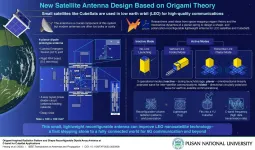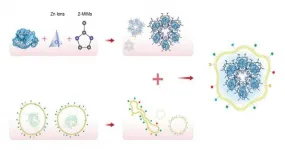(Press-News.org) Experts have spent decades warning us about the rising rates of childhood obesity, which has become an epidemic among recent generations in many places around the world, including Spain. The transition from the traditional Mediterranean diet to the consumption of processed foods with low nutritional value is a key contributor, with child-targeted advertising also partly to blame. According to the Breakfast Food Advertisements in Mediterranean Countries: Products' Sugar Content in Adverts from 2015 to 2019 report produced by UOC Faculty of Information and Communication Sciences professor and researcher, Mireia Montaña, the majority of breakfast products marketed for children contain three times as much sugar as those aimed at adults, influencing their choices for one of the most important meals of the day.
The study, published in the open access journal, Children, analysed a total of 355 advertisements from 117 different products between 2015 and 2019, and specifically concluded that the average amount of sugar in the breakfast products analysed and advertised for adults was 10.25%, with that figure increasing to an average of 36.20% when it came to products aimed at children. In other words, the breakfast options being promoted for children through the various communication channels are less healthy than those aimed at their parents. Indeed, if you looked at it in terms of the most heavily promoted children's breakfast products, you would think that the majority of Spanish children are starting their day fuelled by biscuits, which account for 60% of breakfast-related advertising, and chocolate-based products, such as spreads and drinking chocolate, which make up 25% of the ads.
According to Mireia Montaña, "Although much of the adult population still adhere to the Mediterranean diet, it is a practice that is waning among children and young people, who are increasingly opting to eat processed industrial products with a high sugar content for breakfast."
Mònika Jiménez, professor of Advertising and Public Relations at Pompeu Fabra University (UPF) and co-author of another study involving Montaña, entitled Breakfast Food Advertising and Prevention of Obesity: Analysis of the Nutritional Value of the Products and Discursive Strategies Used in the Breakfast Ads from 2015 to 2019, warned of the dangers of persuasive advertising in relation to food products of low nutritional value. She said: "the less closely a product correlates to that which would be deemed healthy nutritional parameters, the greater the tendency for the advertising discourse to focus on hedonism or happiness and tend towards persuasion." As Jiménez explained, when discourse alludes to positive emotions, happiness and the things that product can help you achieve, it stimulates certain areas of the brain that lead us to consume, a strategy which "is especially harmful in relation to certain audiences, such as minors, because they are very susceptible to these kinds of stimuli."
The 'pester power' effect
As Montaña's study points out, one of the consequences of advertising campaigns that market breakfast products to children is the increased amount of processed foods being purchased as breakfast options for children that then end up being consumed by the whole family. This is a phenomena known as 'pester power', which is defined as "the influence of children on the purchasing habits of their parents," explained Montaña, who is also a researcher with the UOC's GAME - CNM (Learning, Media and Entertainment; Communication and New Media) group. She added that, "Children tend to insistently ask for things so that their parents end up giving in and buying food products that are advertised extensively or that have some extrinsic component that attracts children but that have very little nutritional value."
The study by professors Montaña and Jiménez found that the communication channel most widely used to convince consumers to purchase these low nutritional quality products was television. According to their analysis, television accounted for 39% of breakfast product advertising, with radio coming in at 28%, the internet, 18%, newspapers 6%, magazines, 5%, outdoor advertising, 2% and cinema, 0.56%. "TV is the most effective medium when it comes to persuading children. And when is it that children are going to the supermarket with their parents and end up imposing their preferences with regard to what goes into the shopping trolley? Precisely when they are younger, up until preadolescence," Jiménez pointed out.
The two experts highlighted a number of strategies related to advertising that could be implemented to promote healthy eating habits that prevent childhood obesity. The first being to restrict advertising for certain unhealthy foods that, as Montaña stressed, are "aimed at young children who are yet to develop their powers of critical thinking". Spain already has a regulatory framework in place that was introduced 15 years ago as part of the NAOS (Nutrition, Physical Activity and Prevention of Obesity) Strategy, which led to the development of the PAOS Code for the regulation of advertising aimed at minors that would promote childhood obesity. However, the code only covers those products that are exclusively aimed at children. As Jiménez explained: "[D]rinking chocolate is a product that is also perfectly applicable to adults and, therefore, is not subject to the code. Furthermore, these advertisements are not always exclusively broadcast during restricted children's viewing times, which is another tactic that can be used to circumvent the regulation."
In addition to the need for a more stringent regulatory framework, a variety of other actions could be implemented to help reduce current levels of childhood obesity, including, "effective education on the subject of nutrition in general, both for parents and children". "Another policy that could work well, would be to increase the rate of VAT on certain products, as has already been done in the case of soft drinks," suggested the UOC professor, concluding with the reminder that an obese child is likely to develop into an obese adult.
INFORMATION:
This study supports Sustainable Development Goal (SDG) 3 on good health and well-being.
Reference Articles
Montaña Blasco, M. "Breakfast Food Advertisements in Mediterranean Countries: Products' Sugar Content in the Adverts from 2015 to 2019". Children 2021, 8, 14. https://doi.org/10.3390/children8010014.
Montaña Blasco, M.; Jiménez-Morales, M. "Breakfast Food Advertising and Prevention of Obesity: Analysis of the Nutritional Value of the Products and Discursive Strategies Used in the Breakfast Ads from 2015 to 2019". Nutrients 2021, 13, 231. https://doi.org/10.3390/nu13010231
UOC R&I
The UOC's research and innovation (R&I) contribute to solving the challenges facing the global societies of the 21st century by studying how technology and the human and social sciences interact, with a specific focus on the network society, e-learning and e-health.
Over 500 researchers and 51 research groups work among the University's 7 faculties and 2 research centres: the Internet Interdisciplinary Institute (IN3) and the eHealth Center (EHC).
The United Nations 2030 Agenda's Sustainable Development Goals and open knowledge provide strategic pillars on which the UOC's teaching, research and innovation are built.
More information: research.uoc.edu. #25yearsUOC
In recent years, active, self-propelled particles have received growing interest amongst the scientific community. Examples of active particles and their systems are numerous and very diverse, ranging from bacterium films to flocks of birds or human crowds. These systems can demonstrate unusual behavior, which is challenging to understand or model.
To this end, large-scale models of active particles were being scrutinised by experts at Leicester, in order to understand basic principles underlying active particle dynamics and apply them in a scenario of an evacuation strategy for customers in crowded place. Unexpectedly, the 'super-particles' milling in a circular motion were stumbled upon ...
There's a reason that ideas--even erroneous ones--catch fire on social media or in popular culture: groupthink.
New research co-authored by Berkeley Haas Asst. Prof. Douglas Guilbeault shows that large groups of people all tend to think alike, and also illustrates how easily people's opinions can be swayed by social media--even by artificial users known as bots.
In a series of experiments, published in the journal Nature Communications, Guilbeault and co-authors Damon Centola of the University of Pennsylvania and Andrea Baronchelli of City University London created an online game that asked numerous people to identify ...
Just as beneficial microbes in the human gut can be affected by antibiotics, diet interventions and other disturbances, the microbiomes of other animals can also be upset. In a rare study published this week, Andrea Jani, a researcher with the University of Hawai'i at Mānoa School of Ocean and Earth Science and Technology (SOEST), determined the skin microbiome of an endangered frog was altered when the frogs were infected by a specific fungus, and it didn't recover to its initial state even when the frog was cured of the infection.
All animals host symbiotic microbes--many ...
WASHINGTON--Chinese people are more likely to face high blood pressure and other health risks as a result of higher body mass index (BMI) and waist circumference than people from other racial and ethnic groups, according to a new study published in the Endocrine Society's END ...
SINGAPORE, 10 February 2021 - Researchers studying an enzyme in fruit fly larvae have found that it plays an important role in waking up brain stem cells from their dormant 'quiescent' state, enabling them to proliferate and generate new neurons. Published in the journal EMBO Reports, the study by Duke-NUS Medical School, Singapore, could help clarify how some neurodevelopmental disorders such as autism and microcephaly occur.
Quiescent neural stem cells in the fruit fly larval brainPr-set7 is an enzyme involved in maintaining genome stability, DNA repair and cell cycle regulation, as well as ...
Modern telecommunication systems rely on satellites to relay signals across the globe quickly and reliably, enabling users to send messages across the world in an instant, watch live television, or - more recently - hold conference calls with global partners right from the kitchen table!
Communications satellites use high-frequency radio waves to transmit data, with antennas acting as a two-way interface, converting electric current provided by the transmitter into radio waves, and vice versa when paired with a receiver. Antennas are therefore vital pieces of equipment, without which satellites and ground receivers would be practically useless. However, despite advances in modern satellite design and performance, antenna technology remains a limiting factor for ...
With the advent of 5G communication technology and its integration with AI, we are looking at the dawn of a new era in which people, machines, objects, and devices are connected like never before. This smart era will be characterized by smart facilities and services such as self-driving cars, smart UAVs, and intelligent healthcare. This will be the aftermath of a technological revolution.
But the flip side of such technological revolution is that AI itself can be used to attack or threaten the security of 5G-enabled systems which, in turn, can greatly compromise their reliability. It is, therefore, imperative to investigate such potential security threats and explore countermeasures before a smart world is realized.
In a recent study published ...
Researchers at the University of Virginia School of Medicine have shed light on what causes herpes simplex virus to flare up, explaining how stress, illness and even sunburn can trigger unwanted outbreaks.
The discovery could lead to new ways to prevent cold sores and herpes-related eye disease from reoccurring, the researchers report.
"Herpes simplex recurrence has long been associated with stress, fever and sunburn," said researcher Anna R. Cliffe, PhD, of UVA's Department of Microbiology, Immunology and Cancer Biology. "This study sheds light on how all these triggers can lead to herpes simplex-associated disease."
About Herpes Simplex ...
Joe Biden is the new president of the United States, although half of the country's Republicans believe he stole the election. A lot of people believe conspiracy theories on the other side of the Atlantic. But they aren't only found there.
Conspiracy theories are not exclusive to people who storm the U.S. Capitol.
"Everyone believes at least one conspiracy theory," says Asbjørn Dyrendal, a professor in NTNU's Department of Philosophy and Religious Studies who specializes in conspiracy theories.
The more conspiracy theories you bring up, the more people answer yes to one of them.
That fact leads ...
Loading a cancer immunotherapy drug onto a metal organic framework improves both its delivery and its sustained release for treating leukemia. Furthermore, coating the drug-loaded framework with a cancer cell membrane improves targeted delivery to solid tumors. These findings could lead to safer and more reliable cancer immunotherapies.
"We believe our findings are quite significant because they show that the undesirable side effects of immunotherapy can be modulated by choosing the right delivery vehicle," says KAUST chemist Niveen Khashab. "They also show that targeted delivery can be realistically established through proper surface functionalization." ...





